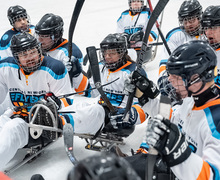Experts explain how SU’s rapid response contained COVID-19 cluster
Emily Steinberger | Photo Editor
Syracuse University was monitoring 99 cases of the virus among students and employees in central New York at the height of the cluster.
The Daily Orange is a nonprofit newsroom that receives no funding from Syracuse University. Consider donating today to support our mission.
At the height of an emerging coronavirus cluster on campus about two weeks ago, Syracuse University was monitoring 99 cases among students and employees in central New York.
As of Monday, SU reported 12 active cases among students and employees in the area — a drastic decrease following a spike that nearly forced the university to transition to online classes.
“It was a combination of luck and a lot of hard work to contain that,” said David Larsen, an associate professor of public health at SU who has informed the university’s coronavirus response. “It looks like it was contained.”
SU has largely contained the container three weeks after officials first announced it. Public health experts said a combination of student cooperation, a rapid response from university officials and sheer luck allowed SU to limit its spread.
The cluster likely began when at least one SU student traveled to Binghamton, which New York state had deemed a coronavirus hotspot, university officials have said. SU’s public health guidelines ask students to stay in central New York for the duration of the semester. The virus then spread further at at least one gathering at an apartment complex on Walnut Avenue.
The university’s contact tracing team, led by personnel at the Barnes Center at The Arch, traced the spread of the virus beyond the initial close contacts of those who were at the super-spreading event, Larsen said. At the cluster’s peak, over 280 students were in quarantine due to possible exposure.

Shannon Kirkpatrick | Senior Design Editor
While the university can’t definitively state it identified and contained every case associated with the cluster, it succeeded in catching a vast majority, Larsen said.
“Barnes Center led the charge and really busted this cluster,” he said. “There’s still potentially chains of transmission that we didn’t catch that might show up a little bit with this big campus-wide testing, but we suspect that we got it.”
Vice Chancellor Mike Haynie, the head of SU’s coronavirus response, has said students involved with the cluster cooperated with contact tracers, allowing the university to quickly isolate additional cases.
Most coronavirus infections do not travel very far, said Larsen, who served on SU’s Public Health and Emergency Management Subcommittee, which advised the university on the public health implications of resuming in-person classes this semester.
Coronavirus “super-spreaders” — such as the person who attended the party on Walnut Avenue where the cluster began — tend to spread the virus further because of a combination of biological factors and social networks, Larsen said. In this case, the individual was shedding “lots of infectious virus,” he said.
SU is currently testing the entire student body with pooled saliva testing for the third time this semester. All students must receive a test by Tuesday.
Brooks Gump, a professor of public health at SU, said the university managed to contain the cluster because of its “aggressive response.” The university’s contact tracing, testing, quarantine and isolation procedures contained cases before they spread, he said.
“The message here is that traditional public health approaches do work,” Gump said. “You want to tailor your response to be as aggressive as needed.”
On Oct. 6, when the cluster was first reported, SU suspended all in-person activities except academics and intercollegiate athletics, closing campus fitness centers and limiting in-person gatherings to five people or fewer. SU reopened the Barnes Center at The Arch on Oct. 15 and relaxed restrictions on in-person activities. But the university has kept the maximum number of people allowed at nonessential, off-campus gatherings at five.
Under Gov. Andrew Cuomo’s guidance for reopening schools, colleges and universities that report 100 coronavirus cases within a fixed two-week period must stop residential instruction and limit in-person activities for at least two weeks. During the two-week period ending Oct. 9, SU reported 80 new cases, just 20 under the state’s limit.
Haynie has said preventing the cluster from spreading to residence halls was a critical part of containing it. As of Oct. 12, the university had only identified two cases related to the cluster in residence halls: one in Watson Hall and one in DellPlain Hall.
While the university’s wastewater surveillance program did not catch the initial cluster, it did help SU identify that the outbreak had not spread substantially in dorms, Larsen said. Wastewater surveillance won’t predict “super-spreader” events because the virus spreads too quickly for the wastewater to pick it up, especially since Onondaga County is only testing the wastewater of off-campus neighborhoods once per week, he said.
Haynie has said at least 95% of cases related to the cluster were among students living off campus.
Although the cluster spread largely among students off campus, that did not necessarily make it easier to contain, both Larsen and Gump said. While the virus can spread quickly in residence halls because of shared spaces, students living off campus who regularly come to campus can continue to spread it among the student population if they don’t follow public health guidelines, Gump said.
“We’re very fortunate that it wasn’t in the dorms, but you know it’s not to dismiss the severity of it,” Larsen said.
Had more than one super-spreader event happened at the same time, SU may not have been equipped to handle the spread, Larsen said.
“One ‘super-spreading’ event we can handle, but when you start getting them chained together in multiples, then it’s just overwhelming transmission and basically you just have to shut down,” Larsen said. “We didn’t see other super-spreading events.”
Published on October 26, 2020 at 10:26 pm
Contact Mira: mlberenb@syr.edu






